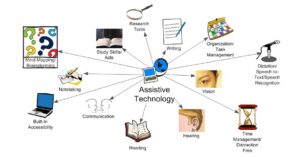Technology definitely enhances learning. Technology doesn’t ALWAYS enhance learning, but it definitely does enhance it…most of the time…some of the time…wait, no. Technology should be banned in schools.
Yes, Let’s go back to the basics…
Reading.
Writing.
Textbooks.

But wait…what about students with exceptional abilities? They need technology to support their learning. Yes, schools should definitely have tech available for all students.

But…wait again. What about factoring in privilege, accessibility, and perhaps the biggest hinderance to many school districts: funding? OH! and furthermore…what about addiction related to technology? Online bullying? Too much screen time?
These conflicting thoughts and aspects of this multi-faceted argument ping-ponged in my mind as I weighed both sides of this argument.
I took the week to ponder and attempt to reach to a firm conclusion. At first, I was very adamantly on the side of “yes, of course technology definitely and most certainly always enhances learning.” I thought it was a complete no-brainer. However, as I listened to the two sides of the debate and then later in the week, the coinciding Ted Talks and read the articles, I became more of a fence-sitter.
I have certainly witnessed technology be of huge use for tackling the task of teaching in a triple-grade classroom. When I taught in rural Saskatchewan, this was the only way to successfully cover the majority of three curriculums for three entire grades in one school year. Two grades could be working on an assignment previously posted on Google classroom, while I taught the other grade, and we could rotate through this way to fill our day. Of course, there’s also the usefulness when it comes to assisted learning efforts. I have seen this virtually every year as a useful tool, and each year in completely new and further advanced way.
As stated in the ‘Class, Take Out Your Tablets: The Impact of Technology on Learning and Teaching in Canada:”
“Some educators noted that technology helped them provide additional flexibility in sharing education materials and tracking assignments. For example, the use of individual learning programs can offer students the ability to work at their own pace. It allows them to reread lessons with written and visual cues to ensure the material is fully understood and digested. This is of particular benefit for those with mild learning disabilities, particularly in the areas of reading or writing. The use of assistive technology is another clear example of how students with disabilities can benefit. Interviewees specifically noted that broader integration of technology in the classroom removes the stigma of assistive technology for students with functional needs for education. While 10 years ago, technology may have been an identifier of a student with a disability, today, it can unite and bring students together. A common example is text-to-speech software, which can help students who have difficulties reading standard print.81 Educational software offerings from the large technology companies in this space are also working to improve accessibility through the use of a variety of features such as high-contrast modes, screen magnifying/resolution options, predictive text, and guided access for those with autism or other attention or sensory challenges. 82 83 This was experienced first-hand by one Canadian educator interviewed in this study who noted witnessing verbal translation (via voice-to-text software) help bridge the communication divide for a deaf student who was also learning English.”
These examples are just a few of hundreds of ways that teachers use technology to enhance and support learning. I am still a member of this side of the argument, but I did waver a bit after reading the articles and listening to the argument on the other side…especially after learning that some members of Silicon Valley’s tech world send their own children to schools that have a no tech policy.
As Wexler comments, technology can often just become a distraction, or be used to siphon misinformation from the vast world wide web. It can also lead to laziness where students may have the attitude of “I’ll just Google it” instead of memorizing facts.
These few bits made me rethink my stance, and while valid, don’t supersede the general helpfulness of technology in classrooms.
Viva la tech!
2 Comments
Janeen Clark
“Interviewees specifically noted that broader integration of technology in the classroom removes the stigma of assistive technology for students with functional needs for education. While 10 years ago, technology may have been an identifier of a student with a disability, today, it can unite and bring students together.”
Amanda, this same passage stood out to me. I often think about this as some of my students who are in modified programs bring their own tech to class. In the past, this has definitely stood out as an identifier of “difference.” Now, we all use laptops so often, and some students even bring in their own regularly, it’s not such a big deal. In the same way, I am now hyper-aware of using phones in my class. It used to be that half the class would have a phone, but now, 95 percent of kids have phones. I will often bring laptops in for the one or two that don’t have phones, and it always feels uncomfortable to me. I have taken to framing it as, “If your phone is almost dead, or you just prefer to work on a bigger screen, here are laptops you can use…” and then bring in a few more laptops.
Amanda Stecyk
Hi Janeen, I really love how you framed the choice of using a laptop in class for preferential reasons or battery life reasons. It really helps to turn it into less-obvious scenario for those students who do not have their own devices. I am going to borrow that phrase for sure! -Amanda